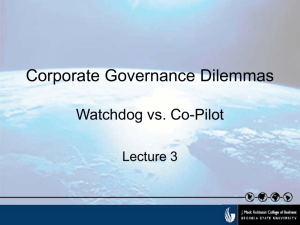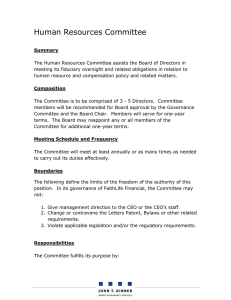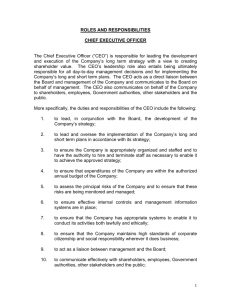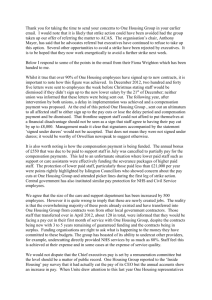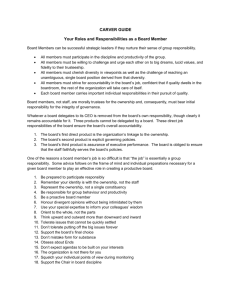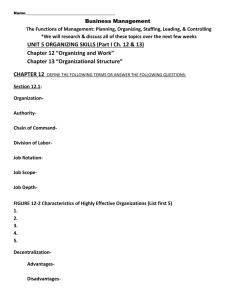3 Stewardship Theory or Agency Theory: Governance and Shareholder Returns
advertisement
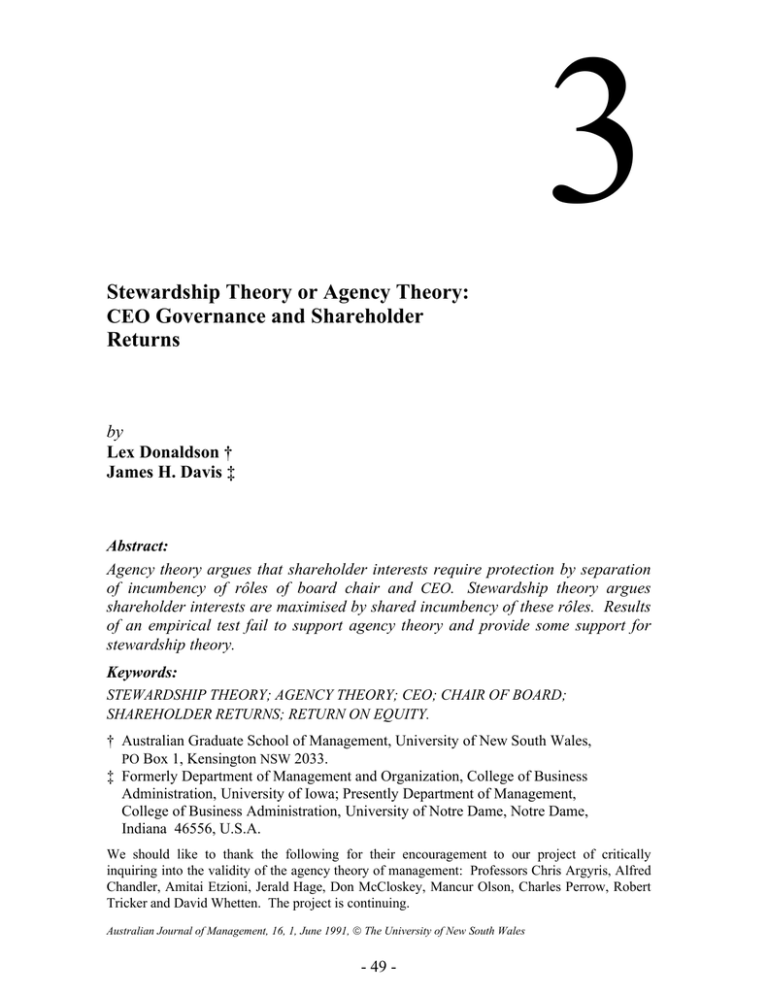
3 Stewardship Theory or Agency Theory: CEO Governance and Shareholder Returns by Lex Donaldson † James H. Davis ‡ Abstract: Agency theory argues that shareholder interests require protection by separation of incumbency of rôles of board chair and CEO. Stewardship theory argues shareholder interests are maximised by shared incumbency of these rôles. Results of an empirical test fail to support agency theory and provide some support for stewardship theory. Keywords: STEWARDSHIP THEORY; AGENCY THEORY; CEO; CHAIR OF BOARD; SHAREHOLDER RETURNS; RETURN ON EQUITY. † Australian Graduate School of Management, University of New South Wales, PO Box 1, Kensington NSW 2033. ‡ Formerly Department of Management and Organization, College of Business Administration, University of Iowa; Presently Department of Management, College of Business Administration, University of Notre Dame, Notre Dame, Indiana 46556, U.S.A. We should like to thank the following for their encouragement to our project of critically inquiring into the validity of the agency theory of management: Professors Chris Argyris, Alfred Chandler, Amitai Etzioni, Jerald Hage, Don McCloskey, Mancur Olson, Charles Perrow, Robert Tricker and David Whetten. The project is continuing. Australian Journal of Management, 16, 1, June 1991, The University of New South Wales - 49 - AUSTRALIAN JOURNAL OF MANAGEMENT June 1991 1. Introduction R ecent thinking about strategic management and business policy has been influenced by agency theory. This holds that managers will not act to maximise the returns to shareholders unless appropriate governance structures are implemented in the large corporation to safeguard the interests of shareholders (Jensen and Meckling 1976). The board of directors has an important function here and in particular the relationship between the chairperson and the chief executive officer is key (Tricker 1984). Shareholder interests will be safeguarded only where the chair of the board is not held by the CEO or where the CEO has the same interests as the shareholders through an appropriately designed incentive compensation plan (Williamson 1985). Such a view, however, runs counter to other thinking about strategic management which holds that a more critical factor for shareholder returns is a correctly designed organisation structure which allows the CEO to take effective action. The present paper seeks to contrast these two views about the governance and incentive of the CEO and subject them to empirical tests. The discussion herein cautions against too ready acceptance of the agency theory model of CEO rôle and rewards. And the paper introduces the alternate approach to corporate governance of stewardship theory. 2. Theory A gency theory argues that in the modern corporation, in which share ownership is widely held, managerial actions depart from those required to maximise shareholder returns (Berle and Means 1932; Pratt and Zeckhauser 1985). In agency theory terms, the owners are principals and the managers are agents and there is an agency loss which is the extent to which returns to the residual claimants, the owners, fall below what they would be if the principals, the owners, exercised direct control of the corporation (Jensen and Meckling 1976). Agency theory specifies mechanisms which reduce agency loss (Eisenhardt 1989). These include incentive schemes for managers which reward them financially for maximising shareholder interests. Such schemes typically include plans whereby senior executives obtain shares, perhaps at a reduced price, thus aligning financial interests of executives with those of shareholders (Jensen and Meckling 1976). Other similar schemes tie executive compensation and levels of benefits to shareholders returns and have part of executive compensation deferred to the future to reward long-run value maximisation of the corporation and deter short-run executive action which harms corporate value. In like terms, the kindred theory of organisational economics is concerned to forestall managerial “opportunistic behaviour” which includes shirking and indulging in excessive perquisites at the expense of shareholder interests (Williamson 1985). A major structural mechanism to curtail such managerial “opportunism” is the board of directors. This body provides a monitoring of managerial actions on behalf of shareholders. Such impartial review will occur more fully where the chairperson of the board is independent of executive management. Where the chief executive officer is chair of the board of directors, - 50 - Vol.16, No.1 Donaldson & Davis: STEWARDSHIP THEORY the impartiality of the board is compromised. Agency and organisational economics theories predict that when the CEO also holds the dual rôle of chair, then the interests of the owners will be sacrificed to a degree in favour of management, that is, there will be managerial opportunism and agency loss. The “model of man” underlying agency and organisational economics is that of the self-interested actor rationally maximising their own personal economic gain. The model is individualistic and is predicated upon the notion of an in-built conflict of interest between owner and manager. Moreover, the model is one of an individual calculating likely costs and benefits, and thus seeking to attain rewards and avoid punishment, especially financial ones. This is a model of the type called Theory X by organisational psychologists (McGregor 1960). There are, however, other “models of man” which originate in organisational psychology and organisational sociology. Here organisational rôle-holders are conceived as being motivated by a need to achieve, to gain intrinsic satisfaction through successfully performing inherently challenging work, to exercise responsibility and authority, and thereby to gain recognition from peers and bosses (McClelland 1961; Herzberg et al. 1959). Thus, there are non-financial motivators. Moreover, identification by managers with the corporation, especially likely if they have served there with long tenure and have shaped its form and directions, promotes a merging of individual ego and the corporation, thus melding individual self-esteem with corporate prestige. Again, even where a manager may calculate that a course of action is unrewarding personally they may nevertheless carry it out from a sense of duty, that is, normatively induced compliance (Etzioni 1975). Further, while agency theorists posit a clear separation of interests between managers and owners at the objective level (Jensen and Meckling 1976), this may be debatable, and organisational sociologists would point out that what motivates individual calculative action by managers is their personal perception (Silverman 1970). To the degree that an executive feels their future fortunes are bound to their current corporate employers through an expectation of future employment or pension rights, then the individual executive may perceive their interest as aligned with that of the corporation and its owners, even in the absence of any shareholding by that executive. These theoretical considerations argue a view of managerial motivation alternative to agency theory and which may be termed stewardship theory (Donaldson 1990a, 1990b; Barney 1990). The executive manager, under this theory, far from being an opportunistic shirker, essentially wants to do a good job, to be a good steward of the corporate assets. Thus, stewardship theory holds that there is no inherent, general problem of executive motivation. Given the absence of an inner motivational problem among executives, there is the question of how far executives can achieve the good corporate performance to which they aspire. Thus, stewardship theory holds that performance variations arise from whether the structural situation in which the executive is located facilitates effective action by the executive. The issue becomes whether or not the organisation structure helps the executive to formulate and implement plans for high corporate performance (Donaldson 1985). Structures will be facilitative of this goal to the extent that they - 51 - AUSTRALIAN JOURNAL OF MANAGEMENT June 1991 provide clear, consistent rôle expectations and authorise and empower senior management. Specifically, as regards the rôle of the CEO, structures will assist them to attain superior performance by their corporations to the extent that the CEO exercises complete authority over the corporation and that their rôle is unambiguous and unchallenged. This situation is attained more readily where the CEO is also chair of the board. Power and authority are concentrated in one person. There is no room for doubt as to who has authority or responsibility over a particular matter. Similarly, the expectations about corporate leadership will be clearer and more consistent both for subordinate managers and for other members of the corporate board. The organisation will enjoy the classic benefits of unity of direction and of strong command and control. Thus, stewardship theory focuses not on motivation of the CEO but rather facilitative, empowering structures, and holds that fusion of the incumbency of the rôles of chair and CEO will enhance effectiveness and produce, as a result, superior returns to shareholders than separation of the rôles of chair and CEO. In policy discussion to date, there has been some tendency to approach the issue of CEO duality from within a perspective akin to agency theory (Kesner and Dalton 1986). Commentators have noted that among large U.S. corporations, the majority have CEOs who are also the board chair (Kesner and Dalton 1986). The proportion is presently about eighty per cent (Dalton and Kesner 1987). There is some evidence that this proportion has risen over the years, and that the U.S. has an unusually high proportion of CEO duality, especially relative to the competitor nation of Japan (Kesner and Dalton 1986; Dalton and Kesner 1987). In Australia, only a small minority of large corporations have CEO duality (Korn-Ferry 1988). This widespread practice of CEO duality has been roundly criticised in the U.S. and calls have been made to create separate incumbents of the rôles of CEO and board chair to restore industrial performance and shareholder returns (Kesner and Dalton 1986). An implication of agency theory is that where CEO duality is retained, shareholder interests could be protected by aligning the interests of the CEO and the shareholders by a suitable incentive scheme for the CEO, i.e. by a system of long-term compensation additional to basic salary. Where CEOs hold the dual rôle of chair, the presence of long-term compensation will align their interests with shareholders and forestall the loss in shareholder benefit which otherwise will result from the dual rôle. Any superiority in shareholder returns observed among dual CEO chairs over independent chairs would be explained away by agency theory as being due to the spurious effects of financial incentives. By contrast, stewardship theory would hold that any observed superiority in shareholder returns from CEO duality was not a spurious effect of greater financial incentives among CEO-chairs than among independent chairs. Thus, agency theory yields two hypotheses regarding CEO governance: AH1: CEO duality leads to lower returns to shareholders. - 52 - Vol.16, No.1 Donaldson & Davis: STEWARDSHIP THEORY AH2: Any observed positive effects of CEO duality are caused by long-term compensation and are spurious. By contrast, stewardship theory yields two opposite hypotheses regarding CEO governance: SH1: CEO duality leads to higher return to shareholders. SH2: The positive effects of CEO duality are not due to the spurious effects of long-term compensation. The present study will test these four hypotheses to provide an examination of the empirical validity of these two competing theories regarding the rôle and rewards of the CEO. It should be noted that the primary focus of the present study is on the rôle structure issue of CEO duality, rather than on the study of rewards. Accordingly, the long-term compensation variable and hypotheses are introduced in the nature of a control in order to deal with the issue of alternative agency theory explanations of any positive findings about CEO duality. 3. Previous Research B erg and Smith (1978) studied the relationship between whether or not the CEO and board chair rôles were held by the same person and financial performance. They found a significant statistical association on ROE, which was only one out of the three financial performance indicators they examined. But the report is unclear, with the sign of the relationship differing as between the text (Berg & Smith 1978:35) and the table (Berg & Smith 1978:39). Thus, the results of Berg and Smith study must be coded as weak and equivocal. Rechner and Dalton (1991) examined the relation between CEO duality and organisational performance. Their study supports agency theory expectations about inferior shareholder returns from CEO duality. They studied a random sample of corporations from the Fortune 500. Rechner and Dalton (1991) identified corporations which had remained as either dual or independent chairCEO structures for each year of a six-year period (1978–1983). They found that corporations which had independent chair-CEO structures had higher return on equity (ROE), return on investment (ROI) and profit margins. But Rechner and Dalton (1991) made no control for industry in their study, so the extent of any confounding of structure effects by industry effects is unknown. It is thus desirable to assess effects of structure on shareholder returns controlling for industry effects. Thus, there is need for a further study of the relation of CEO duality and its effects. Rechner and Dalton (1989) also examined the effect of CEO duality on riskadjusted shareholder returns using stock market data for the same sample and period. They found no significant difference between structures (Rechner and Dalton 1989). Thus, there is a need for a further study of shareholder stock market returns. - 53 - AUSTRALIAN JOURNAL OF MANAGEMENT June 1991 4. The Study T he present study is an examination of the effects of CEO duality on shareholder returns. The study aims to control for exogenous effects on shareholder returns by controlling for industry, which proxies numerous factors such as product, market, competition and so on, and also for size, a known influence on organisational performance (Schoeffler 1983). Ideally, the study would use a longitudinal design and examine changes in structure and their effects on changes in shareholder returns. But the present study is cross-sectional in method, which makes causal inference less certain. Corporations whose board structures have a dual CEO-chair are compared with those where the chair is independent from the CEO. Since previous research shows board structure to change only slowly, and mostly towards more duality (Kesner and Dalton 1986; Rechner and Dalton 1991), the implication is that structure at one time point will reflect structure at the earlier time quite well. The dual structure companies will likely include a small minority who were independent some years earlier. Since structure will have a lagged effect on shareholder returns, it is the structure some years earlier which is the cause of present shareholder returns. Therefore, present structures will represent the true causal independent variable with some error, but this will be mostly limited in degree and mainly restricted to the presently dual structures being diluted by some cases of, until recently, independent structures. This will reduce to a degree the true difference between structures, rendering the present test conservative. But such source of error is unlikely to lead to a cross-over with present independent structures recording the true effects of dual structures and vice versa. Thus, present test results will likely understate true effects of structure on performance but will be a fairly reliable indication. 5. Methodology T he sample is a convenience sample of 337 U.S. corporations taken from a compensation survey based upon data drawn from Standard and Poor’s Compustat Services Inc. (Business Week, May 2, 1988). Up to sixteen firms were excluded because of their structure or incomplete data, leaving 321 firms minimum in the sample. Data were checked by reference back to Standard and Poor, and in some cases of ambiguity by contacting the company directly. The companies covered a wide range of industries and were classified here into seven industry groups: consumer products, high technology, financial services, low technology, resources, transportation/service, and utilities. Size data were taken from Standard and Poor’s Industrial Reports and the Million Dollar Directory. Size was operationalised as number of employees and ranged from fifty to 915,000 employees, that is, from large Fortune 500 sized corporations to much smaller companies. Thus, this sample is not a representative random sample, but is fairly large and covers a range of organisations and sizes, yielding variation. The proportion with CEO duality structures was 76%, very similar to the 79% obtained by Rechner and Dalton (1991), adding confidence that our sample is not - 54 - Vol.16, No.1 Donaldson & Davis: STEWARDSHIP THEORY idiosyncratic. The board structure was coded as presence of CEO duality if the top executive, CEO or President, was also the chair of the board in 1987. The board structure was coded as independent chair if the board chair was not also the CEO or other executive position. Thus, board structure was a binary code. Long-term compensation was also coded as a dichotomy, present if any long-term compensation was recorded by the survey additional to salary and bonus, and absent otherwise. Where there was CEO duality the long-term compensation coding was based on the CEO; where there was an independent chair the long-term compensation coding was on the top executive. Shareholder returns were measured by return on equity, that is, profit generated on shareholder funds. Such profits form the basis of return to shareholders through dividends and appreciation of stock price. The higher the ROE, the higher the gain obtainable to shareholder per dollar invested in equity in the company. The average ROE over the three years 1985 to 1987 indexed the level of ROE and registers the longer-term effect of CEO duality on the level of shareholder return. Any change in level of ROE caused by a change in board structure which persists over time should be captured by the measure. But shorter-run effects of board structure on ROE, especially of corporations which changed board structure after 1984, will not be tapped. Hence, the present measure is a conservative estimation of the impact of board structure on ROE. A second measure of shareholder returns was the gain in shareholder wealth by 1987 from holding shares in the corporation. The gains are the capital gains from share price appreciation plus dividends, for holding the share for three years from 1985. They are expressed relative to the initial price, that is the price a shareholder would have paid to acquire the stock in 1985. This baseline figure is expressed as $100 to produce an index of shareholder wealth, with more than $100 being a gain in wealth by a shareholder and less than $100 being a loss. This shareholder wealth measure has the disadvantage that, since many corporations would have changed their structure prior to 1985, the impacts on price of stock up to 1985 would be compounded into 1985 price and so would not register as a post-1985 gain. This means that the share price appreciation component of the index registers only post-1985 gains, though the effect on dividends will be registered. For many corporations which changed structure prior to 1985, the index will register only medium-term or long-term gains in shareprice. Moreover, if there are shorter-run positive impacts of structure on stock price, these will already have raised the price of stock by 1985, thus raising the baseline of the index. Hence, the 1985–87 gain will have to be proportionately larger for corporations which changed structure prior to 1985 to score the same on the shareholder wealth index as the stock of a company which did not change structure and so did not register positive increase in stock price prior to 1985. For these reasons, the shareholder wealth measure used in this study is a conservative estimate of the benefits to shareholders of different board structures. - 55 - AUSTRALIAN JOURNAL OF MANAGEMENT June 1991 6. Results T able 1 shows that the average return on equity of the board with chairs independent of the CEO was 11.49% (N = 78; SD = 11.18), less than the average ROE of those companies with CEO duality, 14.75% (N = 251; SD = 10.32). The difference was 3.26% and was statistically significant (at p < 0.05). Thus, dual CEO structures outperform independent chair structures. To control for possible industry effects, the difference between ROE means was calculated separately for each of the seven industries, thereby expressing ROE relative to industry averages. When these industry relative effects were recombined to give overall effects net of industry, CEO duality structures still out performed independent chair structures significantly (at p < 0.05), though the mean difference was reduced to 2.38%. Size was not associated with ROE in this sample so it was not necessary to control for size. Thus, contrary to agency theoretic expectations, CEO duality is associated with higher return to shareholders than is an independent chair of the corporate board (hypothesis AH1 is rejected). The results support stewardship theory (hypothesis SH1 is accepted). Turning to financial incentives of the CEO, the presence of long-term compensation for the CEO was not associated with higher ROE (see Table 2). Mean ROE for corporations whose CEO received no long-term compensation was 14.38% (N = 141; SD = 11.05) and for corporations whose CEO received longterm compensation was 14.10% (N = 188; SD = 10.32), not significantly different. Thus, these incentive schemes for the CEO do not secure higher returns to shareholders. Nor is there evidence that the high performance of the dual CEO-chairs was brought about by financial incentives for the CEO aligning their interests with the shareholders (see Table 1). Among corporations with CEO duality, the mean ROE for those whose CEO’s had no long-term compensation was 14.13% (N = 108; SD = 11.60), and for those corporations whose CEO had long-term compensation the mean ROE was 15.37% (N = 140; SD = 8.91); this is not significantly different (p = 0.05). The ROE for corporations with CEO duality and no long-term compensation, at 14.13%, was only slightly lower than the average ROE of 14.75% of corporations with CEO duality—indicating that the high ROE average of corporations with CEO duality is not caused by the fact that some of their CEOs had long-term compensation incentives. Thus, hypothesis AH2 was rejected and SH2 was accepted. In summary, the superiority of independent chair board structures and CEO financial incentives on shareholder returns as posited by agency theory was not found on ROE. The positive relationship between CEO duality and shareholder returns posited by stewardship theory was found on ROE. Since these results are the opposite of those of Rechner and Dalton on ROE (1991), the possibility arises that the present findings are due to the different size range of their and our study; being of large corporations (Fortune 500) and both large and smaller corporations, respectively. Restricting the present sample down to just the larger (Fortune 500) corporations produces no real change, however. Mean ROE is 16.97% (N = 137; SD = 8.75) for corporations with CEO duality and - 56 - Vol.16, No.1 Donaldson & Davis: STEWARDSHIP THEORY Table 1 Independent Board Chair and Shareholder Returns _ _______________________________________________________________ Shareholder Return on Equity Board Chair Difference of Mean S.D. N Means _ _______________________________________________________________ Board Chair Independent of Top Executive Held by Top Executive 11.49% 14.75% 11.18% 10.32% 78 251 sig. (p < 0.05) Controlling for Incentive Alignment Chair held by Top Executive: with long-term compensation 15.37% 8.91% 140 with no long-term compensation 14.13% 11.60% 108 n.s. _ _______________________________________________________________ Table 2 Incentive Alignment of C.E.O. and Financial Effects ________________________________________________________________ Incentive Structure Difference of Mean S.D. N for C.E.O. Means ________________________________________________________________ Corporate ROE Performance Long-term compensation No long-term compensation 14.10% 14.38% 10.32% 11.05% 188 141 n.s. Shareholder Wealth1 Long-term compensation $179.05 $66.89 185 No long-term compensation $174.93 $86.74 136 n.s. ________________________________________________________________ Note: 1. Shareholder Wealth is the total value in 1987 produced through share price appreciation plus dividends of a $100 invested in shares of a corporation in 1985. 12.81% (N = 41; SD = 8.33) for corporations with independent chair, which is statistically significant (at p < 0.05). Thus, the present results, that CEO duality is associated with higher shareholder returns than independent chair, stand for larger - 57 - AUSTRALIAN JOURNAL OF MANAGEMENT June 1991 corporations, and the reason for the difference between the Rechner and Dalton (1991) and present study results lie elsewhere. Turning to the index of shareholder wealth (see Table 3), the shareholder wealth in 1987 of independent chair structures, relative to the original base price of $100 in 1985, was $166.39 (N = 75; SD = $66.39) which was less than the shareholder wealth for the corporations with CEO duality of $175.30 (N = 246; SD = $63.45). Table 3 Independent Board Chair and Shareholder Wealth ______________________________________________________________________ Shareholder Wealth1 Difference of Means Mean S.D. N Means ______________________________________________________________________ Board Chair Independent of Top Executive Held by Top Executive $166.39 $175.30 $66.39 $63.45 75 246 n.s. Controlling for Incentive Alignment Chair held by Top Executive: with long-term compensation $179.54 $63.92 138 with no long-term compensation $172.15 $66.18 106 n.s. ______________________________________________________________________ Note: 1. Shareholder Wealth is the total value in 1987 produced through share price appreciation plus dividends of a $100 invested in shares of a corporation in 1985. This difference of $8.91 was, however, not statistically significant (p = 0.05). Controlling for industry effects the difference again was not statistically significant (p = 0.05). Once again, size had a very small relationship to shareholder wealth (r = −0.10) and so was not a confound. For shareholder wealth hypotheses, AH1 was rejected as was SH1. Regarding the long-term compensation, the mean shareholder wealth was $174.93 (N = 136; SD = $ 86.74) without long-term compensation of the CEO and $179.05 (N = 185; SD = $ 66.89) with long-term compensation (see Table 2). This difference was not significant (at p = 0.05). Within corporations with CEO duality (see Table 3), the difference in shareholder wealth with and without long-term compensation was also not significant (p = 0.05). Again, the superior performance of the corporations with CEO duality relative to those with an independent chair cannot be explained by the presence of long-term compensation incentive schemes for some of the CEOs in the CEO duality structures. Among CEO duality structures - 58 - Vol.16, No.1 Donaldson & Davis: STEWARDSHIP THEORY those corporations whose CEOs had no long-term compensation produced shareholder wealth of $172.15 which is only a little below the average for CEO duality structures of $175.30 and is above the average for independent structures of $166.39. Thus, the superior shareholder wealth of the CEO duality structure cannot be explained as a spurious effect of financial incentives for the CEO. Hypothesis AH2 was rejected and hypothesis SH2 was supported, in the qualified sense that the nonsignificant positive effect of CEO duality was not a spurious effect of incentives. The results indicate that, contrary to agency theory, having an independent chair does not lead to gains to shareholder wealth. There is, rather, a positive relationship between CEO duality and shareholder wealth. This is not statistically significant, but the present test is a conservative one (for the reasons stated earlier). There may be a larger positive effect of CEO duality on shareholder wealth which would be revealed by a fuller study. It is also possible that long-term compensation may also be attenuated herein for some reason, such as the use of a dichotomy rather than a continuous variable which records the amount of longterm compensation, and subsequent study may reveal a more positive impact of long-term CEO compensation on shareholder wealth. 7. Discussion T he present study finds that shareholder returns, in terms of ROE, are superior when there is CEO duality. This might be interpreted that shareholder returns cause CEO duality. But even if there is a positive effect of performance on duality, the agency theory explanation would hold only if the correlation between duality and performance was the net result of that positive correlation and the negative effect of duality on performance hypothesised by agency theory. Normally, one would expect that the net result of a negative and positive effect would cancel each other out leaving a correlation about nil. Here the observed correlation is positive between duality and performance, meaning that if there was a positive effect of performance on duality this would have to be more than the supposed negative effect of duality on performance. Only then is there a masking effect which can be used to explain why the agency theory negative effect of duality on performance fails to show the expected negative correlation herein between duality and performance. In order to examine this question there is a need for future research to go beyond the present cross-sectional design to a longitudinal research design into causality. While the greater shareholder wealth of CEO duality over independent chair structures failed to reach statistical significance, this financial market result reinforces confidence in the result from the accounting measure of performance, ROE, that there is no superiority of independent over CEO duality structure. The shareholder wealth index used here does not control for risk in the manner of Rechner and Dalton (1989) and this would need to be assessed for a more definite judgement about the effects of structure on shareholder wealth. Acknowledging this reservation and the non-significance of the shareholder wealth result, and - 59 - AUSTRALIAN JOURNAL OF MANAGEMENT June 1991 making some allowance for the conservatism of the test, the present results suggest that there may be a long-term positive impact of CEO duality on shareholder wealth, which deserves further study. There is considerable need for further inquiry on this topic of board structure and shareholder returns. In particular, longitudinal inquiry is needed into cause and effect. There is also need to follow the lead of Rechner and Dalton (1989) and utilise more sophisticated, market-based measure which adjust for risk. Moreover, the effect of CEO duality on shareholder returns and corporate performance generally may be contingent upon some institutional factors such as size or complexity (Fama and Jensen 1983) as yet empirically unidentified. These are issues for future research. For the moment, the present results caution against the current tendency to approach questions of CEO rôles and rewards from the agency theory and organisational economic perspectives. Their underlying postulates of narrowly self-interested actors and conflict of interest may be too cynical or conflictful. There is at least some merit in entertaining the alternative theoretical approach of stewardship theory. Therein, the motivation of managers is less problematic and the more crucial factor influencing organisational performance and shareholder returns is the design of the organisational structure so that managers can take effective action (Chitayat 1985). The key issue is thus not to heighten control and monitoring of management, or to make them ersatz owners, but rather to empower executives. Interestingly, other empirical inquiries into aspects of organisation, other than those examined here, have failed to find support for agency theory (Stigler and Friedland 1985). Others have obtained results favourable to stewardship theory (Vance 1978; Sullivan 1988), and others again have obtained mixed results (Rechner and Dalton 1988; see Zahra and Pearce 1989). This lends some support to the idea of stewardship theory. Certainly, stewardship theory deserves further investigation in future work in strategic management whose premises should not be restricted to the narrow confines of agency theory and organisational economics. Ultimately, the question might not be whether agency theory or stewardship theory is the more valid. Each may be valid for some phenomena but not for others. Then the question is what are the switching rules between agency and stewardship theory, i.e., the situational contingencies which define distinct theoretical domains. For instance, agency theory has been shown to have explanatory value on the question of how firms react to “greenmail” (Kosnik 1987). It might be that managers seek to maximise organisational performance and shareholder returns, as stewardship theory states, so long as the fundamental coalition between managers and owners remains intact, that is, the organisation is on-going. Once the continuation of the organisation and employment of managers therein is threatened by the possibility of takeover which might dislodge incumbent executives, then managers react to protect their own self-interest as this is threatened and future organisational prosperity may have no benefits for them - 60 - Vol.16, No.1 Donaldson & Davis: STEWARDSHIP THEORY personally. Thus, the critical switching factor between agency and stewardship theories might be whether the fundamental organisational coalition (Cyert and March 1963; Blau 1964) is secure or jeopardised. 8. Implications for Business and National Policy I f the stewardship theory of CEO governance is corroborated by future research, then the implications for business practice are considerable. In the U.S.A. most large firms presently break the rule about independent board chairs, by having a chair who is also the CEO. The implications of stewardship theory is that breaking the rule does not in fact produce the adverse consequences feared for corporate performance and returns to shareholders and is actually beneficial. Therefore the majority of large U.S. firms have already adopted the better-suited CEO governance structure and there is no need for them to change, despite strident calls for board reform (Kesner and Dalton 1986). The need, rather, is to bring academic theory and social commentary into line with present best practice as it has evolved in the U.S. business community. Moreover, should corporations bow to pressures to appoint independent board chairs the performance of the corporations and the returns to their shareholders would suffer. In Australia, most large corporations already have a board chair who is independent of the CEO. The dictates of agency theory have in a sense been widely followed in Australia. In round figures, about seventy per cent of large Australian corporations have an independent chair (Korn-Ferry 1988), the opposite to the U.S. situation where around 80% of large U.S. corporations have the dual CEO-chair. Australia is, in a way, an experiment on behalf of agency theory. According to agency theory, large Australian corporations would be predicted to be outperforming large U.S. corporations, ceteris paribus. But in view of the results herein—that independent chair governance structure tend to produce superior performance—if they apply generally, then the implication for Australia would be that these independent chair governance structures are in need of change. There is an increasing mood of public criticism of business governance and there is talk of new laws to require all Australian corporations to have an independent chair. Yet this might well suppress the performance of the minority of large Australian firms which would be forced to relinquish a dual CEO-chair and to adopt the independent chair structure. If, on the contrary, a new more liberal attitude to business governance were to be inaugurated, in the spirit of deregulation, and the majority of large Australian corporations were to switch from an independent chair to a dual CEO-chair, then the performance of these corporations would benefit as would their shareholders and, in consequence, so would the Australian economy. But it is possible that there are national or cultural factors which make the relationship between CEO governance and financial outcomes different in Australia from the U.S.A. There is a need for future research to test these relationships on Australian data. Until the Australian situation is examined directly there is a need for caution in extrapolating from U.S. data. But given the lack of clear, consistent support in the U.S. studies to date for the - 61 - AUSTRALIAN JOURNAL OF MANAGEMENT June 1991 supposed benefits of non-executive board chairs, at the present time it would be foolish for Australia to embrace the notion that all companies should be required to have a non-executive board chair. 9. Conclusions T he present paper has outlined two contrasting approaches to the structure of corporate boards: agency theory and stewardship theory. The former emphasises control of managerial “opportunism” by having a board chair independent of the CEO and using incentives to bind CEO interests to those of shareholders. Stewardship theory stresses the beneficial consequences on shareholder returns of facilitative authority structures which unify command by having rôles of CEO and chair held by the same person. The empirical evidence is that the ROE returns to shareholders are improved by combining, rather than by separating, the rôle-holders of the chair and CEO positions. Thus, the results fail to support agency theory and lend some support to stewardship theory. The safeguarding of returns to shareholders may be along the track, not of placing management under greater control by owners, but of empowering managers to take autonomous executive action. (Date of receipt of final typescript: May 1991.) References Barney, J.B., 1990, The debate between traditional management theory and organizational economics: substantive differences or intergroup conflict? Academy of Management Review, 15, 382–393. Berg, S.V. and S.K. Smith, 1978, CEO and Board Chairman: A Quantitative Study of Dual v. Unitary Board Leadership, Directors and Boards, 3, 34–49. Berle, A. and G. Means, 1932, The Modern Corporation and Private Property (New York, Macmillan). Blau, P.M., 1964, Exchange and Power in Social Life (New York, John Wiley). Chitayat, G., 1985, Working relationships between the Chairman of the Boards of Directors and the CEO, Management International Review, 25, 65–70. Cyert, R.M., and J.G. March, 1963, A Behavioral Theory of the Firm (Englewood Cliffs, N.J., Prentice-Hall). Dalton, D.R., and I.F. Kesner, 1987, Composition and CEO duality in boards of directors: an international perspective, Journal of International Business, 18, 3, 33–42. Donaldson, L., 1985, In Defence of Organization Theory, A Reply to the Critics (Cambridge, Cambridge University Press). - 62 - Vol.16, No.1 Donaldson & Davis: STEWARDSHIP THEORY Donaldson, L., 1990a, The ethereal hand: organizational economics and management theory, Academy of Management Review, 15, 369–381. Donaldson, L., 1990b, A rational basis for criticisms of organizational economics: a reply to Barney, Academy of Management Review, 15, 394–401. Eisenhardt, K.M., 1989, Agency theory: an assessment and review, Academy of Management Review, 14, 1, 57–74. Etzioni, A., 1975, A Comparative Analysis of Complex Organizations (New York: The Free Press) Revised and Enlarged Edition. Fama, E.F. and M.C. Jensen, 1983, Separation of ownership and control, Journal of Law and Economics, 26, 301–325. Herzberg, F., B. Mausner, and B. Snyderman, 1959, The Motivation to Work (New York, John Wiley). Jensen, M.C. and W.H. Meckling, 1976, Theory of the firm: managerial behavior, agency costs, and ownership structure, Journal of Financial Economics, 3, 305–360. Jensen, M., and W. Meckling, 1979, Rights and production functions: an application to Labormanaged firms, Journal of Business, 52, 469–506. Kesner, I.F. and D.L. Dalton, 1986, Boards of Directors and the checks and (im)balances of corporate governance, Business Horizons, 29, 5, 17–23. Korn/Ferry International, 1988, Eighth Annual Survey of Boards of Directors in Australia, Sydney. Kosnik, R.D., 1987, Greenmail: a study of board performance in corporate governance, Administrative Science Quarterly, 32, 163–185. McClelland, D.C., 1961, The Achieving Society (Princeton, N.J., Van Nostrand). McGregor, D., 1960, The Human Side of Enterprise (New York, McGraw Hill). Pratt, J.W., and R.J. Zeckhauser, 1985, Principals and agents: the structure of business (Boston, Harvard Business School Press). Rechner, P.L. and D.R. Dalton, 1988, Board composition and organizational performance: a longitudinal assessment, Paper presented to the Academy of Management, Anaheim, 1988. Rechner, P.L. and D.R. Dalton, 1989, The impact of CEO as board chairperson on corporate performance: evidence vs. rhetoric, The Academy of Management Executive, 3, 2, 141–143. Rechner, P.L. and D.R. Dalton, 1991, CEO duality and organizational performance: a longitudinal analysis, Strategic Management Journal, 12, 2, 155–160. Schoeffler, S., 1983, The PIMS program, in: K. Albert (ed.), The Strategic Management Handbook (New York, McGraw-Hill) pp.23.1–23.10. Silverman, D., 1970, The Theory of Organisations (London, Heinemann). Stigler, G.J. and C. Friedland, 1983, The literature of economics: the case of Berle and Means, Journal of Law and Economics, 36, 237–268. Sullivan, M.K., 1988, Outsider versus insider boards revisited: a new look at performance and board composition, Paper presented to the Academy of Management, Anaheim, 1988. - 63 - AUSTRALIAN JOURNAL OF MANAGEMENT June 1991 Tricker, R.I., 1984, Corporate Governance: Practice, Procedures and Powers in British Companies and their Boards of Directors (Aldershot, Hants., Gower). Vance, S.C., 1978, Corporate governance: assessing corporate performance by boardroom attributes, Journal of Business Research, 6, 203–220. Williamson, O., 1985, The Economic Institutions of Capitalism (New York, Free Press). Zahra, S. and J.A. Pearce, II, 1989, Boards of directors and corporate financial performance: a review and integrative model, Journal of Management, 15, 2, 291–334. - 64 - Vol.16, No.1 Donaldson & Davis: STEWARDSHIP THEORY - 65 -
